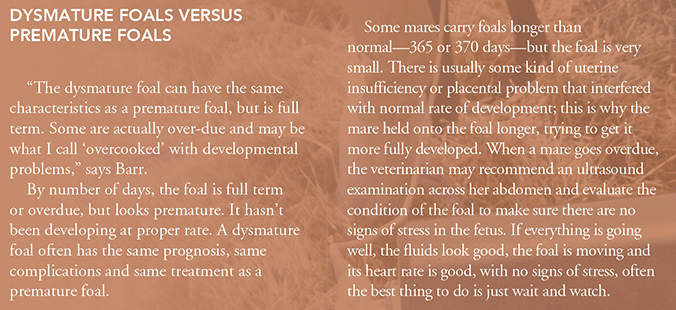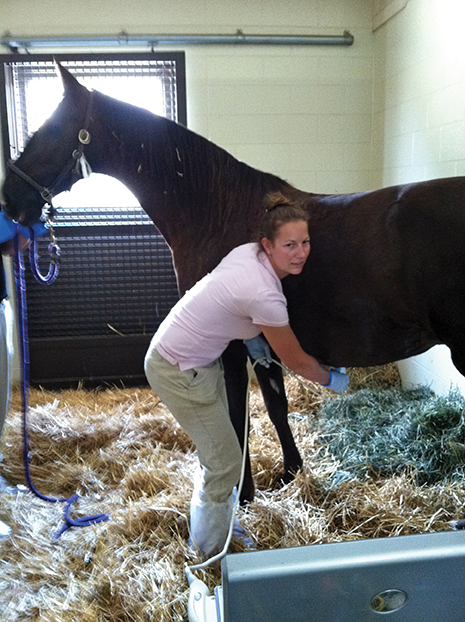
Dealing with Premature Foals
by Heather Smith Thomas
Occasionally a mare foals too early, and the foal is premature. Foals born at less than 320 days’ gestation are considered premature, and chances for survival decrease considerably if a foal comes earlier than 300 days. These foals are not ready for life outside the uterus, and usually need intensive care to survive.
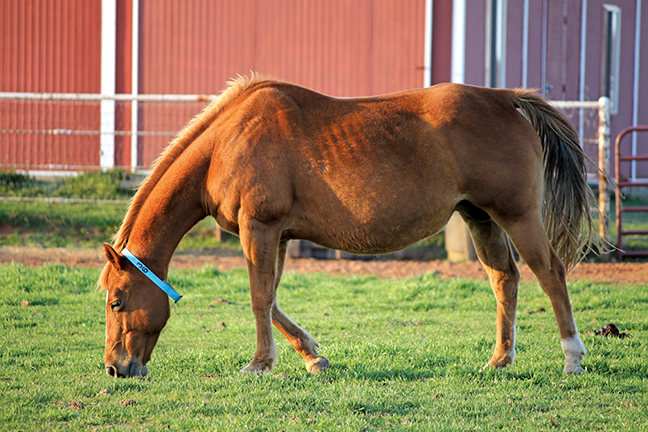 Reasons For Foals Coming Early
Reasons For Foals Coming Early
Dr. Bonnie Barr of Rood and Riddle Equine Hospital, Lexington, Kentucky, says one of the main reasons a foal arrives prematurely is that something is not quite right. “One of the most common reasons is placentitis—which is inflammation or infection of the placenta,” she says. Labor starts too soon, and the fetus is expelled before it is ready for birth. If a mare shows signs that she might be preparing to foal, such as relaxed muscles alongside the tail-head and the start of udder development, she should be checked by a veterinarian. Infection of the placenta or premature separation of the placenta can be detected by ultrasound.
The mare can be put on antibiotics if there’s a placentitis and she can be given Regumate or progesterone to try to keep the cervix tight. She can also be given drugs to keep the uterus from contracting, and sometimes this will enable her to hang onto the pregnancy long enough to have a foal that could have a better chance of surviving.
Onset of labor can be triggered by the mare, by the placenta, or by human management, and sometimes by reasons we don’t fully understand. Placentitis can lead to premature delivery by causing fetal stress. Severe stress to the mare can also cause her to deliver early. “Stress stimulates the body to produce more cortisol, which can trigger labor. Stress in the mare may be due to severe infection, pneumonia, colic, etc. The fetus itself may also trigger onset of labor. This may be due to genetic problems causing organ malfunction, or other problems. Twins can be another reason for foals to be born prematurely,” says Barr.
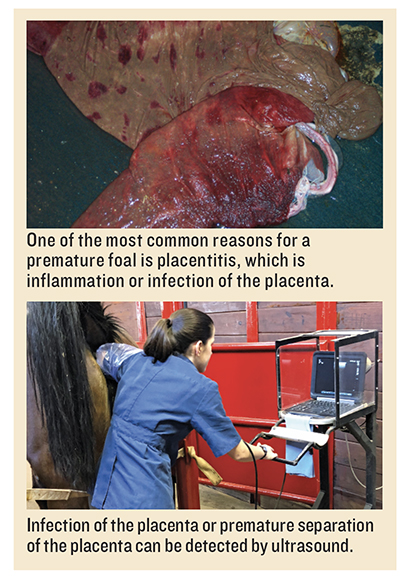
Sometimes human error causes a premature birth, such as giving a mare the wrong drugs. Some tranquilizers may cause uterine contractions, and steroids sometimes trigger labor, as can accidentally giving the mare prostaglandin. There are some drugs and medications that should not be given to pregnant mares.
In some instances, a late-gestation mare may be dying, and the owner chooses to have the veterinarian induce labor to save the foal. For example, she may have a broken leg or some other problem for which there is no hope and the veterinarian and mare owner have decided she cannot survive. We can induce labor or take the foal by Cesarean section. This may not work, but there’s sometimes a chance to save a foal, depending on how close to term it is. Many of the foal’s organ systems mature very late in gestation, particularly the respiratory system--which actually matures due to maternal cortisol levels rising, as happens in a normal birth. That’s why sometimes an induced labor gives the foal a better chance of survival than a C-section.
Signs Of Prematurity
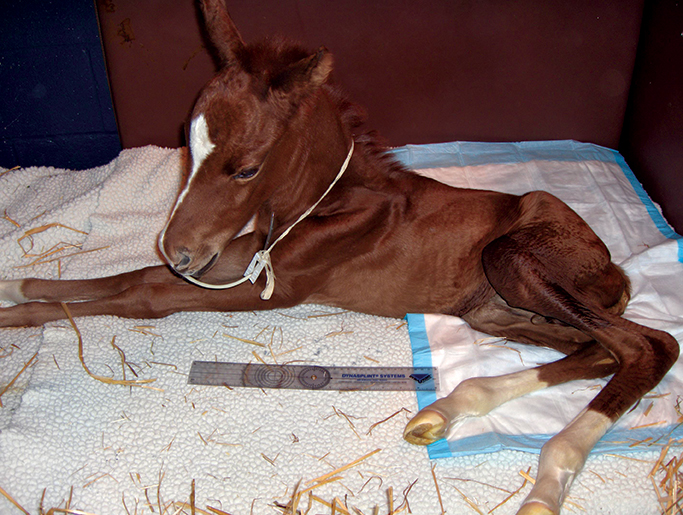 “Textbook definition of prematurity is gestational length, but we generally make our determination based on the characteristics of the foal at birth. These characteristics would be a smaller-than-normal foal, low body weight, poor musculature, laxity of the limbs, etc. The premature foal often has a very short, fine hair coat, floppy ears, and sometimes a small, domed forehead,” says Barr.
“Textbook definition of prematurity is gestational length, but we generally make our determination based on the characteristics of the foal at birth. These characteristics would be a smaller-than-normal foal, low body weight, poor musculature, laxity of the limbs, etc. The premature foal often has a very short, fine hair coat, floppy ears, and sometimes a small, domed forehead,” says Barr.
The foal may be weak or have trouble doing the basic things a normal foal would do. “Premature foals may have a hard time regulating body temperature, so you have to keep them warm. They have a lower heart rate than normal. The foal may have a harder time getting up, and may not nurse right away,” she says. Premature foals don’t maintain hydration very well, and their kidneys may not be as functional as a normal foal. If a foal is dehydrated, his eyelids are more likely to be flipped inward.
The premature foal’s skin is thinner than normal, and the hair coat very short and soft. If the foal spends much time lying down, he ends up with skin ulcers and abrasions just from the pressure on tender skin. It’s important to have soft bedding for the foal and make sure he doesn’t keep lying on the same side too long.
Managing The Premature Foal
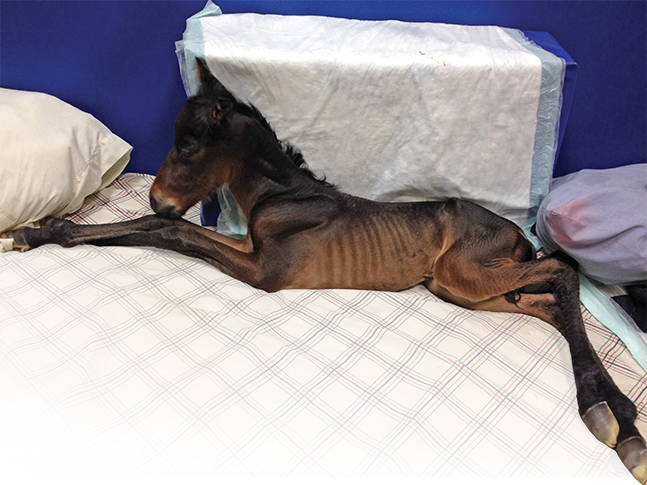
“What the foal will need in terms of care depends on how premature it is and how many of these characteristic problems are evident—and how much help is needed. I have seen some foals from mares with a documented placentitis that an owner or veterinarian has been trying to manage the best they can, yet the foal is born prematurely—but is up and walking around. If the foal is doing everything right, it doesn’t need as much management and intensive care as a foal that isn’t able to stand and walk around,” says Barr. Some of these foals just need close monitoring for a while to make sure they can function normally, while others will need intensive care.
“One thing we always do, if we are suspicious that it’s a premature birth, is x-ray the knees and hocks. We know those bones are the last to mature during gestation. If the foal is born early, those bones may not be completely calcified. You don’t want that foal to be up and walking around too much and putting stress on those bones, or you might end up with the bones being crushed. If that happens, the foal will not be able to grow and develop normally and won’t be an athlete—and might have some crippling in those joints,” she explains. “I always make sure I know what those bones look like before the foal is turned outside with its dam.”
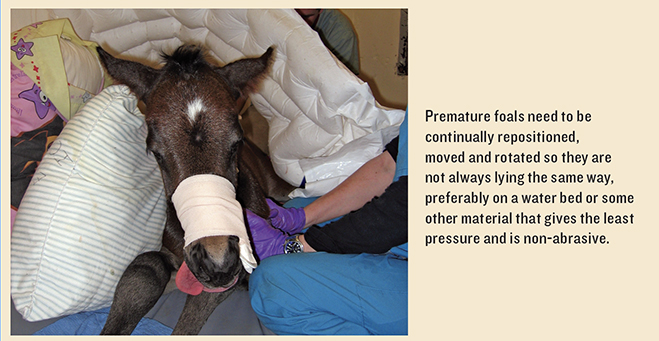 Since the premature foal may also be more vulnerable to infections than a normal foal, prophylactic antibiotics may be given. “The immune system may be too immature to deal with all the different challenges and various things the foal will be exposed to, during and after birth,” says Barr.
Since the premature foal may also be more vulnerable to infections than a normal foal, prophylactic antibiotics may be given. “The immune system may be too immature to deal with all the different challenges and various things the foal will be exposed to, during and after birth,” says Barr.
“We want to make sure the foal gets adequate colostrum, and if it doesn’t, we may follow up with plasma to provide the necessary antibodies. If the foal is unable to nurse, it will need nutrition via IV or feeding tube—milking out the mare and feeding the foal by tube every hour,” she says.
“The foals we take care of here in the hospital that are unable to stand are closely monitored; we measure their urine output and make sure they are passing feces—all the basic functions. Some of them end up with secondary complications like septicemia, and some may end up as dummy foals due to oxygen shortage in utero or during birth. This can lead to neurologic problems.”
Sometimes the lungs are not mature enough to function normally. “These are the foals we really worry about and keep a close eye on. We put them on prophylactic antibiotics to prevent pneumonia. If it were a human baby, it would be given a surfactant (a surface-active lipoprotein complex that reduces surface tension of fluid in the lungs),” says Barr.
Surfactant is naturally produced in the lungs and makes the tiny air sacs more stable and keeps them from collapsing when air is exhaled. The fetus begins making surfactant in late gestation, in preparation for breathing air when it is born, but the premature foal or baby may not have enough yet and will have trouble breathing.
“Human babies can be given a surfactant product, but we don’t have an equivalent product for horses. In my experience, if a premature foal is really struggling to breathe, with respiratory problems due to premature lungs, the foal generally doesn’t survive.”
Premature foals may need fluid more often than a normal foal, but this depends on the situation and the extent of their problems. If the foal is showing neurological signs, this may be due to brain swelling--and overhydrating the foal can make that problem worse. You have to know which electrolytes to give because the balance can be skewed either way; the sodium may go too high or too low, the calcium can go too high or too low. The foal needs very intensive and very expensive monitoring and care, but his best chances are in a neonatal unit at a medical facility where he can be very closely monitored and given proper intensive care. You walk a very fine line with these fragile babies, regarding fluid and electrolyte balance.
“You need to know some answers quickly, and the foal will likely need to be on oxygen, and fluids--fed by nasogastric tube or intravenously. You must also prevent positional pneumonia and pressure sores; these foals need to be continually repositioned so they are not always lying the same way. They need to be moved and rotated, on water beds or some other material that gives the least pressure and is non-abrasive,” says Barr.
There have been a lot of advances in the care of premature foals; we are able to save some now that could not have been saved 20 years ago. The neonatal intensive care units are becoming more specialized and high-tech every year, but we have a long way to go yet with premature foals, compared to human babies.
Prognosis
Survival rate will depend a lot on how compromised the foal is at birth, and any secondary complications. The foal might live but end up crippled or impaired in ways that would prevent an athletic career. “I can only think of a few studies looking at this, following these foals through life and describing the outcome and athletic careers of premature foals. A study from the University of Florida suggested that premature Thoroughbred foals are less likely to be successful athletes when compared to their siblings, but the number of foals in that study was small,” says Barr.
“Another study from Rood and Riddle Equine Hospital, which evaluated the athletic potential of foals with poorly calcified hock bones, concluded that these foals were less likely to race and earned less money than their maternal siblings. A great project for someone would be to look at a large number of premature foals and their outcome and athletic careers. Here in the Thoroughbred world, it would be easy to do, based on whether they are able to race. If they go on to do something else, it might be harder to track them,” says Barr.
Some might end up sound enough to be used for breeding, and some might manage alright in a less-strenuous career than racing. “They might be able to become a riding horse for pleasure, for instance,” she says.
